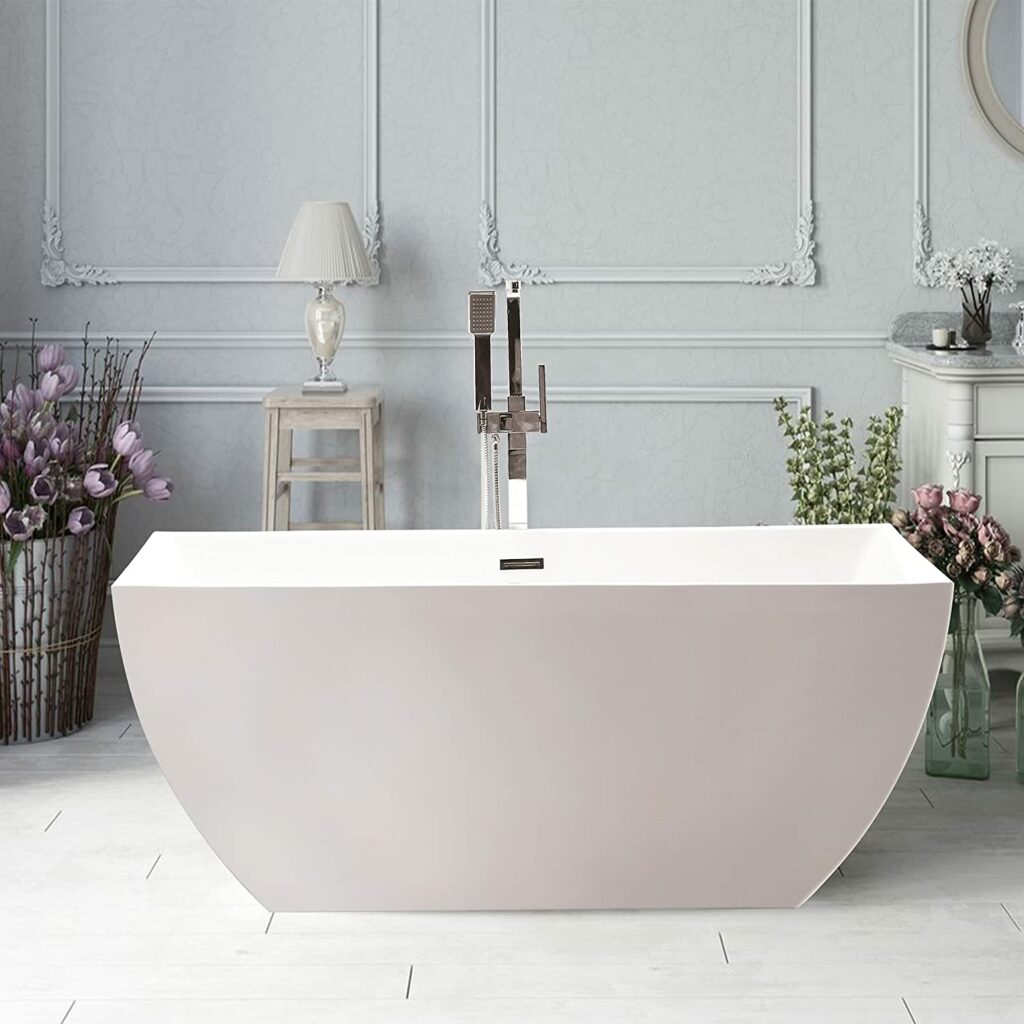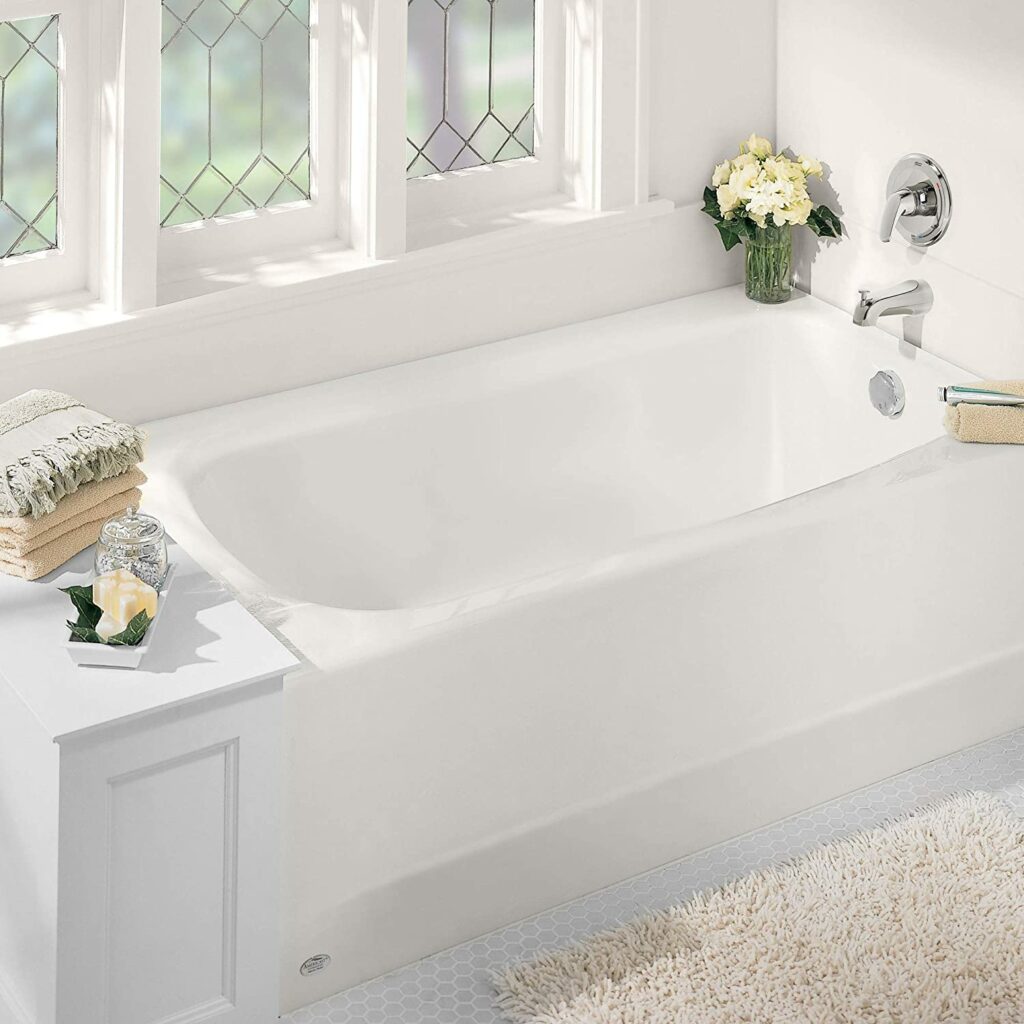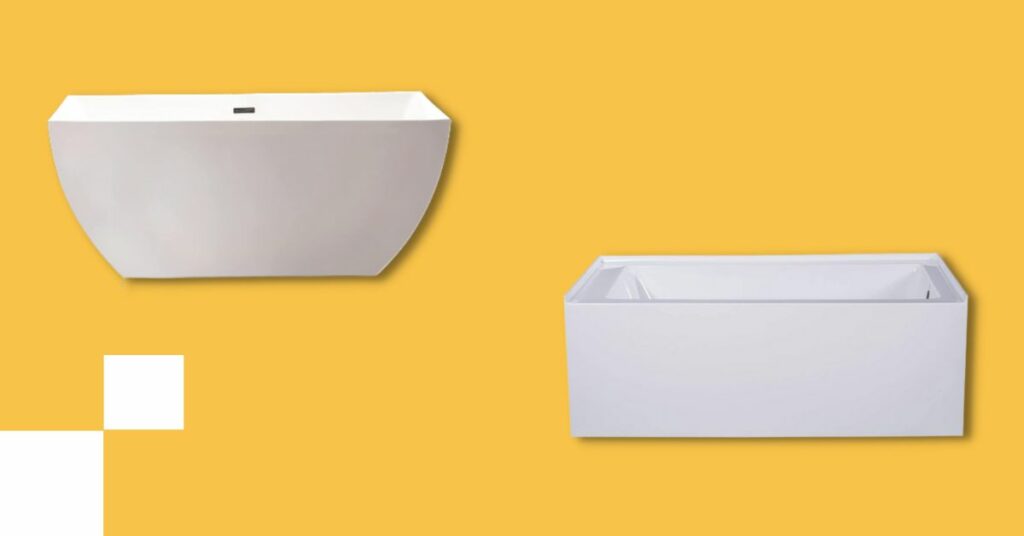When you’re ready to upgrade your bathroom, there is one major decision to make: do you want your bathtub made out of porcelain or acrylic?
While they may seem similar at first glance, porcelain and acrylic are very different options with their own pros and cons.
In this article, we will take a look at the main differences between Acrylic vs Porcelain Tubs to determine which one would work best in your bathroom.
What is Acrylic?

Acrylic is one of the most common materials used in the construction of a bathtub. Acrylic is also known as polymethyl methacrylate, which is a type of plastic. It’s lightweight and easy to install. However, it has low thermal conductivity and heat retention.
What is Porcelain?

Porcelain is a type of ceramic that is more durable than acrylic due to its high thermal conductivity and heat retention capabilities. However, It’s also much heavier than acrylic material.
Difference between Acrylic and Porcelain tubs
Acrylic and porcelain bathtubs both have their benefits and drawbacks, but which one should you choose?
To make the best decision, here’s a quick comparison of acrylic vs porcelain tubs to help you narrow down your options.
Weight
Acrylic bathtubs are much lighter than porcelain bathtubs, which makes them easier to move around.
The weight of each type of bathtub can vary depending on the manufacturer and the size of the tub. Acrylic bathtubs tend to be lighter weight than porcelain ones, although there are some exceptions (e.g., Kohler). Porcelain baths tend to be heavier than their acrylic counterparts because they often include thicker walls and greater depth than their plastic cousins.
Cost
Acrylic is cheaper than porcelain, so if you’re looking for a cheap fix that won’t break the bank when it comes time to replace your tub, go with acrylic. It’s also lighter weight and easier to move around than porcelain—it’s not as heavy as metal and won’t cause any damage if dropped on the floor.
Durability
Porcelain is more durable than acrylic, but acrylic is much cheaper. If you want something that will last for years (and years), then go with porcelain. The material used in porcelain baths doesn’t break down like acrylic does over time—it lasts for decades if properly cared for!
Porcelain baths require special care, but they look more natural and natural-looking than acrylic baths do.
Heat Retention
The main difference between acrylic tubs and porcelain tubs is heat retention. Acrylic holds onto heat longer than porcelain does, which means that it takes longer to cool down after being filled with hot water. This can be helpful if you have children who love baths but hate getting out of them—they’ll still be nice and warm when they’re done! However, it also means that the water will stay hotter for longer after your shower has been running for 10 minutes or so (and therefore use more energy).
Maintenance
Acrylic is easier to maintain than Porcelain because its surface is smoother and less porous than acrylic’s surface; therefore, soap scum doesn’t build up as quickly on porcelain surfaces versus acrylic.
Scratch or Chip Resistant
Porcelain is a more durable option than acrylic, which means it will last longer and look better over time. It’s also less likely to scratch or chip than an acrylic tub.
Resale Value
If you’re planning on selling your house in the future, it may be worth investing in a porcelain tub since it’s more likely to retain its value than an acrylic one. However, if you plan on staying put for a while (or if you want one that’s easier to clean), then an acrylic tub may be more suitable for your needs!
Installation
Acrylic tubs are lighter than porcelain tubs, which makes them easier to install. However, they are more prone to cracking during installation due to their lightweight nature. Porcelain tubs tend to be more durable and less prone to cracking during installation.
Furthermore, Porcelain tubs require professional installation by a plumber or contractor who has experience working with such large items. Acrylic baths, on the other hand, can be installed by anyone who has some basic DIY skills.
Related: Acrylic vs Cast Iron tubs
Scratch Resistance
Acrylic tubs are more scratch resistant than porcelain tubs. This means that they will hold up better over time if you use abrasive cleaners or cleaning products on them regularly. Porcelain is also susceptible to scratching, but if you use only mild cleaners on your porcelain bathtub then it should last for years without any damage whatsoever!
Quality & Material
Both types of bathtubs are made from high-quality materials and should last for many years if properly maintained (i.e., no hard scrubbing with abrasive cleansers).
Pros and Cons of Porcelain vs Acrylic Tub
The first step in choosing the right bathtub is to decide whether you want porcelain or acrylic. Both have their benefits and drawbacks, so it’s important to know what each of them entails before committing to one material over another. To help you out, here are some of the pros and cons of both materials to help you make your decision.
Acrylic Tubs Pros and Cons
Acrylic tubs are very popular in homes across the country. These tubs are a great choice for many reasons however they do have some drawbacks. Let’s take a look at acrylic tubs’ pros and cons
Pros – Great for limited space
Acrylic tubs are made of plastic and can be a great choice for those with limited space. The material is lightweight and easy to install, making it a popular choice for smaller bathrooms.
Pros – Affordable
Acrylic tubs are also affordable, which makes them a good option for those who are looking to save money or those who want to remodel their bathroom on a budget.
Pros – Durable
Acrylic tubs are scratch-resistant, which means they will not get damaged over time from normal use. This makes them an excellent choice for families
Cons – Prone to mold and Mildew
Acrylic can be prone to mold and mildew growth if it isn’t properly cleaned, and it’s not the best material if you have young children because it’s softer than other materials and can be damaged easily by sharp objects like toys.
Porcelain Tubs Pros and Cons
The porcelain tub is a timeless classic that can be found in many homes across the country. Porcelain tubs are an elegant way to add a touch of style and class to your bathroom but they’re also heavy.
Let’s take a look at porcelain tubs’ pros and cons.
Pros – Lasts Longer
Porcelain tubs last longer than fiberglass or acrylic bathtubs, so they’ll hold up well over time and with regular use.
Pros – Scratch Resistant
They’re scratch resistant, so you don’t have to worry about your child’s toys or the dog scratching up your new sink.
Pros – Durable
Porcelain tubs are made out of durable material that can withstand heavy use without getting damaged over time like acrylic tubs can get scratched up easily when they’re used regularly by multiple people at once.
Cons – Expensive
Porcelain tubs are typically more expensive than acrylic models because they require more labor-intensive installation processes than other types of materials do; however this doesn’t necessarily mean they are less than any other material.
Cons – Heavy
Porcelain tubs are heavy, so they’re not ideal for people who have bad knees or hips. If you’re looking for something lighter, try a fiberglass tub instead.
Related: Fiberglass tub vs Porcelain
What Should You Choose Acrylic or Porcelain Tub?
Porcelain and acrylic bathtubs are two of the most popular choices for a new bathtub. They’re both very durable, have a smooth finish, and come in a variety of styles and sizes. Both are excellent options for people looking to remodel their bathroom but in my eyes, acrylic is the best choice.
Acrylic bathtubs are often cheaper than porcelain. They come in many shapes and sizes, from alcove bathtubs to small tubs, and it’s easy to find one that fits your bathroom. Plus, acrylic retains heat better than porcelain.


